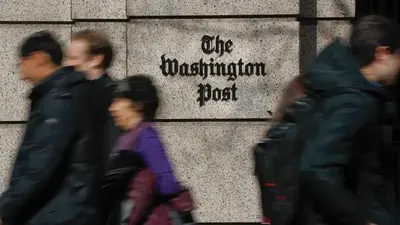Business
Stock market today: Unrelenting rise in Treasury yields drags Wall Street sharply lower
NEW YORK -- Wall Street is sinking Tuesday as it focuses on the downside of a surprisingly strong job market.
The S&P 500 was 1% lower in morning trading and back to where it was in June. The Dow Jones Industrial Average was down 260 points, or 0.8%, at 33,172, as of 10:15 a.m. Eastern time, and the Nasdaq composite was 1.4% lower.
Stocks fell as the pressure on them cranked even higher from rising Treasury yields in the bond market. Such weight has been the main reason the stock market has lost roughly 40% of its value since the end of July, after charging higher for much of the year.
The 10-year Treasury yield climbed again Tuesday, up to 4.75% from 4.69% late Monday and from just 0.50% early in the pandemic. It’s near its highest level since 2007 and rose after a report showed U.S. employers have many more job openings than expected.
When bonds are paying so much more in interest, they pull investment dollars away from stocks and other investments prone to bigger swings in price than bonds. High yields also make borrowing more expensive for companies and households across the economy, which can hurt corporate profits.
Yields have been on the march because investors are increasingly taking the Federal Reserve at its word that it will keep its main interest rate high for a long time in order to drive down inflation. The Fed has already yanked its federal funds rate to the highest level since 2001, and it indicated last month it may keep the rate higher in 2024 than it earlier expected.
Fed Gov. Michelle Bowman said in a speech Monday that she expects it will likely be appropriate “to raise rates further and hold them at a restrictive level for some time.” Restrictive is what Fed officials call high-enough rates to slow the overall economy.
Tuesday's report on the U.S. job market could give the Fed more reason to keep rates high. It showed employers were advertising 9.6 million job openings at the end of August, much higher than the 8.9 million that economists expected.
Such hunger for workers could keep upward pressure on wages to attract employees. While that would be welcomed by workers trying to keep up with iNFLation, the Fed's fear is that could give iNFLation more fuel.
Several other challenges are also tugging at Wall Street, besides higher yields. The resumption of student-loan repayments could drag on spending by U.S. households, which has been strong enough to help keep the economy out of a recession despite high interest rates. Higher oil prices are threatening to worsen inflation, and economies around the world look shaky.
A weaker recovery than expected in China’s economy was one of the main reasons McCormick, a maker of cooking spices, reported slightly weaker revenue for its latest quarter than analysts expected. Its profit matched expectations, but its stock fell 9.5%.
The world’s second-largest economy is also facing a crisis within its property development industry, and Hong Kong’s Hang Seng index tumbled 2.7% as investors unloaded stocks of developers.
However, China Evergrande jumped 28% after resuming trading Tuesday. Its shares were suspended last week as the troubled real estate developer announced that its chairman was under investigation.
Markets in mainland China and South Korea remained closed for holidays, while Japan’s Nikkei 225 index fell 1.6%. Stocks were also lower across much of Europe.
On Wall Street, Point Biopharma, which develops cancer-fighting treatments, soared 84.9% after Eli Lilly said it was buying the company for about $1.4 billion in cash. Eli Lilly fell 2.7%.
Oil prices were ticking higher a day after slumping sharply to trim their big gains since the summer.
A barrel of benchmark U.S. crude rose 0.2% to $89.03 after charging mostly higher from $70 during the summer. Brent crude, the international standard, added 0.1% to $90.83 per barrel.
___
AP Business Writers Matt Ott and Elaine Kurtenbach contributed.
-

 Business10h ago
Business10h agoWelsh sauce firm launches two new merchandise in partnership with Feast
-

 Business12h ago
Business12h agoB2Prime Acquires a Security Dealer License in Seychelles, Expanding Global Operations
-

 Business20h ago
Business20h agoA Call for Embracing AI—But With a ‘Human Touch’
-

 Business1d ago
Business1d agoWhat is New at the Old Groovy Blueberry Location in New Paltz?
-

 Business1d ago
Business1d agoBlaze Ignites Inside LaGrangeville, New York Car Wash
-

 Business1d ago
Business1d agoUS long-term care costs are sky-high, but Washington state’s new way to help pay for them could be nixed
-

 Business1d ago
Business1d agoRhode Island Weather for April 30, 2024 – John Donnelly, meteorologist
-

 Business1d ago
Business1d agoJoe Andruzzi Foundation launches UniCORN: Comprehensive New England cancer resources



























